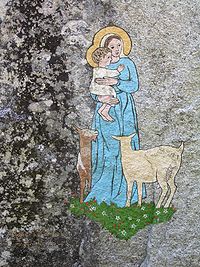
Parietal art
Encyclopedia

Cave
A cave or cavern is a natural underground space large enough for a human to enter. The term applies to natural cavities some part of which is in total darkness. The word cave also includes smaller spaces like rock shelters, sea caves, and grottos.Speleology is the science of exploration and study...
walls or large blocks of stone. One of the most famous examples of parietal art is the Grotte Chauvet in France. Parietal art, or cave art, refers to paintings, murals, drawings, etchings, carvings, and pecked artwork on the interior of rock shelters and caves. The purpose of these paleolithic artworks is not known. However, some theories suggest that these paintings were not solely for decoration as many of them were located in parts of caves that were not easily accessed.
Age
Over 300 caves have been discovered in Spain and France that house parietal art from prehistoric times. Along with the most spectacular, decorated caves have also been found in Africa (e.g. Namibia), Argentina, India, China, Australia and other locations. Cave art was discovered in the 19th century, long before absolute dating was possible, and the antiquity of the art was much debated. Some scholars at the time developed a typology that was overthrown when AMS radiocarbon dating became available. The Lascaux cave, located in France, was discovered in 1940 and is believed to date from around 17000 BC.Interpretations
The initial interpretations of the art at Lascaux and in other related grottos were couched in suggestions that the paintings and engravings were decorative, or just art for art’s sake. Further analysis at the tail-end of the 20th century suggested that the cave art had deep links to prehistoric rituals promoting fertility and successful hunting. Recent studies have found a systematic sequencing in the renditions of horses, aurochs (an extinct ancestor of domestic cattle), and stags, corresponding to seasonal characteristics of each species representing spring, summer, and autumn respectively.Famous Caves Containing Parietal Artwork
Chauvet Cave, Vallon-Pont-d'Arc, FranceDiscovered in 1994 and dating from 30,000 BCE, Chauvet cave comprises two main parts. In the first, most pictures are red, while in the second, the animals are mostly black. The most spectacular images are the Horse Panel and the Panel of Lions and Rhinoceroses. For details and photos, please see: Chauvet Cave Paintings.
Cosquer Cave
Cosquer Cave
The Cosquer cave is located in the Calanque de Morgiou near Marseille, France, not very far from Cap Morgiou. The entrance to the cave is located 37 meters underwater, due to the rise of the Mediterranean in Paleolithic times. It was discovered by diver Henri Cosquer in 1985, but its...
, near Marseille, France
Discovered by the deep-sea diver Henri Cosquer in 1985, and dating from 25,000 BCE, the entrance to Cosquer cave is situated over 100 feet below sea level. It contains, hand stencils, charcoal drawings and about 100 polychrome paintings of horses and other animals. For details and photos, please see: Cosquer Cave Paintings.
Pech-Merle Cave, Cabrerets, Midi-Pyrénées, France
Discovered in 1922, and dating from 25,000 BCE, Pech-Merle is famous for its Dappled Horses, painted in charcoal and ochre on limestone. For details and photos, please see: Pech-Merle Cave Paintings.
Lascaux Cave, Montignac, Dordogne, France
Discovered in 1940 and dating from 17,000 BCE, Lascaux contains seven decorated chambers with over 2000 painted images, including the extraordinary Hall of the Bulls which, despite its name, features mostly horses as well as the male aurochs (wild cattle) from which its name derives. For details and photos, see: Lascaux Cave Paintings.
Font de Gaume, in the Dordogne Valley in France
Discovered in 1901 and dating from 17,000 BCE, Font de Gaume cave contains over 200 polychrome paintings from the Solutrean-Magdalenian culture - second only in France to Lascaux in quality - featuring some 80 bison, 40 horses and 20 mammoths.
Cueva de La Pasiega, Cuevas de El Castillo, Cantabria, Spain
Discovered in 1911 and dating from 16,000 BCE, the cave of La Pasiega consists of one main gallery, some 80 yards in length, with openings to several secondary galleries. Its cave art consists of over 700 painted images (roughly 100 deer, 80 horses, 30 ibex, 30 cattle, along with reindeer, mammoth, birds and fish) including numerous abstract symbols (ideomorphs) and engravings.
Cave of Altamira, near Santillana del Mar, Cantabria, Spain
Discovered in 1879 and dating from 15,000 BCE, Altamira is considered by archeologists and art historians to be "the Sistine Chapel of Paleolithic Art", due to its high quality large scale wall paintings. Its ceiling is regarded as the crowning artistic achievement of the Magdalenian period. The so-called polychrome chamber houses some 30 large animal pictures, mostly bison, vividly executed in red and black pigment. For details and photos, please see: Altamira Cave Paintings.

